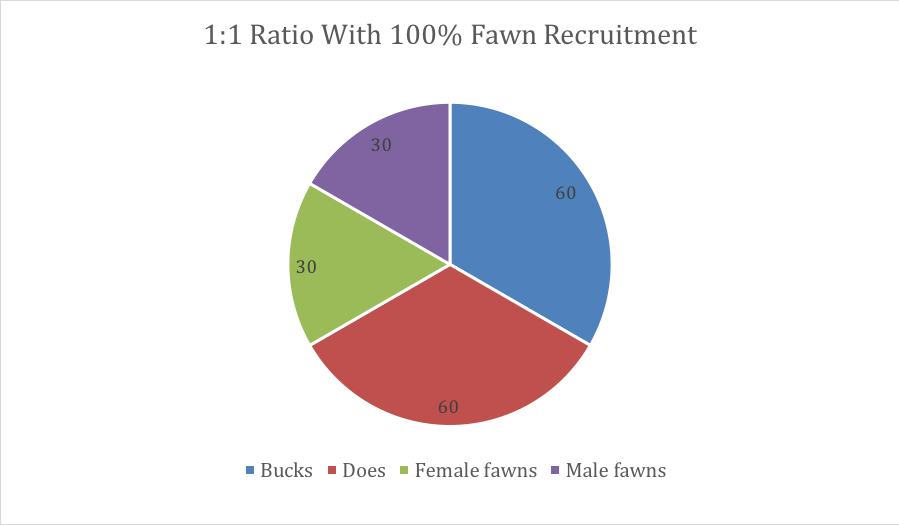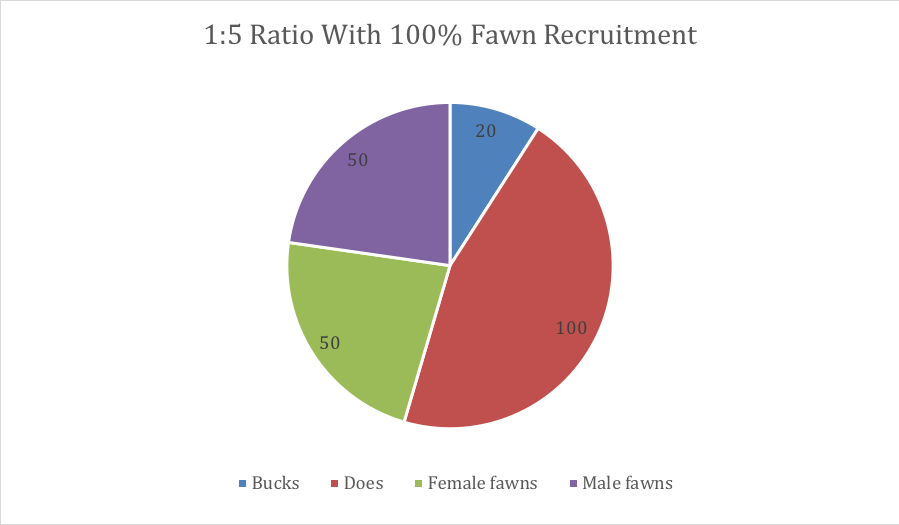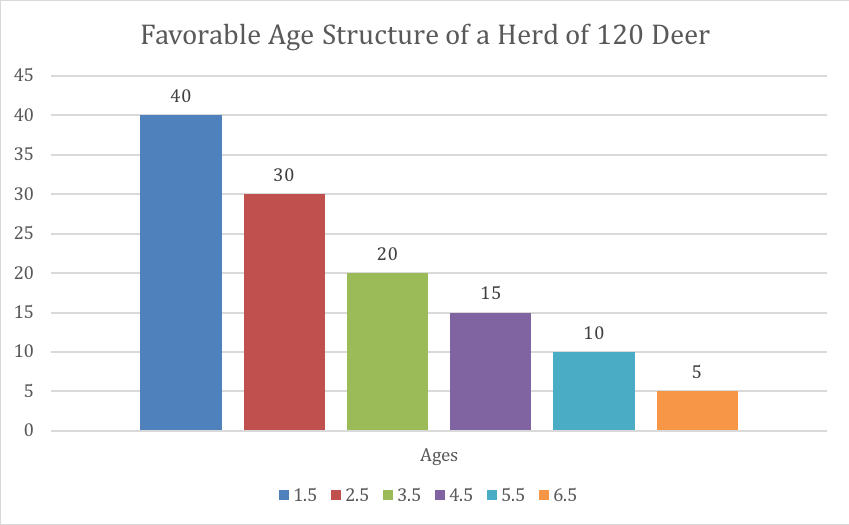If you've read the preceding two posts regarding the management of white-tailed deer does and white-tailed deer bucks, then we are ready to discuss the importance of age structure and sex ratios within your white-tailed deer herds. Like we wrote before, most deer herd management is aimed toward improving the quality of bucks.
These white-tailed deer herd characteristics are manipulated to allow bucks reach their full potential. Bucks will start growing antlers at one year of age and antler growth usually peaks around 6 years. Uninformed harvest strategies can result in land owners and lease holders preventing bucks from reaching maturity.
Here I will discuss how to better manage herds to allow for older bucks and a well distributed range of doe ages.
Understanding White-tailed Deer Herd Turnover
Before I get into specific strategies, I need to define a few concepts I will be referring to. The time required for all older deer to be replaced by younger deer is called "turnover." The amount of time required for a herd to turnover is directly affected by sex ratios and age structures. If only older deer are harvested each year, then the older age class will not last long enough to reach maturity.
Likewise, if a herds’ sex ratio is biased toward does with few bucks, and older bucks are harvested, the buck turnover would be short. Short turnover intervals make big buck management nearly impossible.
Determine Your Habitat's Carrying Capacity
Another concept that requires explanation is that of a habitat’s carrying capacity. In this case, carrying capacity refers to the maximum number of deer a habitat can maintain without degradation to the land or the herd. Populations above carrying capacity can lack nutrition and productivity because the land cannot support the excess deer. Populations under carrying capacity typically exhibit better overall health and productivity because there is no shortage of food. Browse surveys are commonly conducted in conjunction with deer population surveys to determine if a population is above, below, or at carrying capacity. If vegetation is browsed to the ground and tree lines show obvious browse lines where deer have eaten everything they can reach, then the herd is overpopulated for that land.
If vegetation is abundant and regrowth of young trees and vines is obvious, then the population is likely under or at the carrying capacity of the land. Cattle grazing can dramatically lower a land’s carrying capacity for deer. These factors are used to shape deer herd harvest strategies.
Necessary Assumptions
We will have certain assumptions for the following scenarios. First, assume the deer herds in these examples are at carrying capacity with their habitat. Secondly, assume the herd is healthy with a 100% fawn crop annually. Lastly, assume no natural mortality is occurring. Yes, natural mortality will happen. Vehicular collisions, predators, disease, and age will claim a certain number of deer each year, but for these examples assume otherwise. It is also important to mention that true census and age structure data cannot be collected on low fence ranches. The following examples assume this data are known:
Buck to Doe Ratio Examples
We are going to have to do some light math here so bear with me. Assume your herd is at a carrying capacity of 120 deer with an optimal 1:1 buck - doe ratio. Assuming 100% fawn production, 30 male and 30 female fawns are recruited from the 60 does annually. To return this population of 180 back to carrying capacity of 120, 60 deer will need to be harvested.
If only older deer are removed through selective harvests of bucks and does, the next years’ population will consist of 30 older bucks, 30 older does, and 60 yearlings. If this pattern continues the population will turnover on the third year.
Desirable Buck to Doe Ratios
Managing for an even ratio of bucks and does through select harvesting is a good way to ensure bucks reach maturity. Legal bucks with undesirable antler characteristics, of all ages, should be removed to prevent them from passing on their genetics. This will allow desirable bucks to contribute more to the gene pool.
Leaving the best bucks and select does to grow to 5.5 - 6.5 years will allow for longer turnover intervals and better antler characteristics.

Less Desirable Buck to Doe Ratios
Less desirable buck – doe ratios with more variation are problematic for herd turnover management. Let us examine what would happen with a 1:5 ratio. With 120 deer as our carrying capacity and population size we have 20 bucks and 100 does at the start. Deer are promiscuous breeders, so the first year 50 doe and 50 bucks are recruited as fawns. This scenario would require 100 deer be removed from 70 bucks and 150 does to return the population to carrying capacity.
If only mature bucks and does are harvested, this would create a turnover in just one year. Severe doe harvests would be required to return this population to a more favorable ratio.

Deer Herd Age Structure
Now that we are all experts on sex ratio management, let us discuss age structure management. Optimal white-tailed deer herds will have some older, some middle aged, and some young deer. Productive deer herds are maintained at or below carrying capacity. Without removing excess deer from herds, food can become limited and overall herd health could decline. Since antlers typically peak around 6 years of age, managing for a 6-year turnover is a great way to maximize the number of trophy bucks in a population.
Fawn Recruitment
Only 17% fawn recruitment is required each year for a six-year turnover interval. With 100% fawn production and a 1:1 sex ratio, this means more deer are recruited annually than needed. A percentage of these will be lost to natural mortality, but for this example we are assuming they all reach 1.5 years. Thinning heavily from the 1.5-year-old age class will be necessary to maintain proper age structure and improve genetics. Remember that older does are more productive and most have proven to be effective breeders. Some of these does should be retained until they reach 3.5-4.5 years.
That will require thinning more heavily from young and middle-aged deer each year to maintain carrying capacity. The graph below is illustrating a favorable age structure of our hypothetical white-tailed deer herd where the sex ratio for the entire herd is 1:1, but not all age classes have to be. The 5.5 and 6.5 age classes can be reserved for the quality bucks you have been passing on for years.

Adequate deer harvesting cannot always be achieved with state-issued deer tags alone unless you invite your friends and family to help you. If your property qualifies for managed land deer permits (MLDP) through Texas Parks and Wildlife, you can be issued excess tags with reduced harvest restrictions. The MLDP contract requires compliance each year so ensure you can meet the demand before applying. Contact Pond King today for help surveying your deer herd and for tailored deer herd management recommendations.



